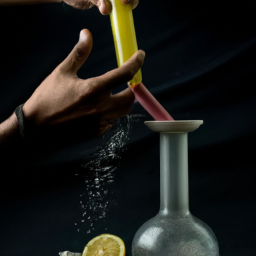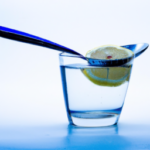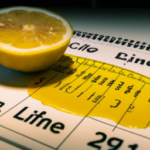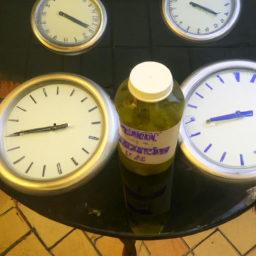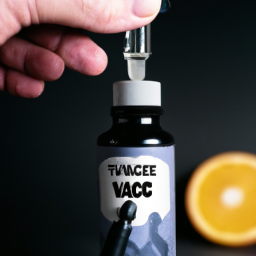Keeping my bong spotless is essential for my smoking routine. It’s not just about the bong looking brand new; it also improves the overall experience of my smoking sessions. Resin and buildup can negatively impact the flavor and potency of my smoke over time. That’s why I prefer using lemon juice, a natural and powerful cleaning solution.
Before diving into the steps, let’s briefly discuss why lemon juice is a great option for cleaning your bong. Lemon juice contains citric acid, which is a natural solvent that breaks down and dissolves the buildup of resin and residue. It also has antibacterial and antifungal properties, making it a safe and effective choice for cleaning your smoking equipment.
So, let’s gather our supplies and get started on cleaning our bong with lemon juice.
Key Takeaways
- Lemon juice is a natural and effective cleaning solution for bongs due to its citric acid content that dissolves resin and residue.
- Bongs should be disassembled and each piece rinsed thoroughly before being soaked in a lemon juice and water solution (1:3 ratio) and shaken vigorously to dislodge stubborn residue.
- Regular maintenance, such as rinsing the bong with warm water after every use and deep cleaning with lemon juice or alcohol weekly, is crucial for a good smoking experience and to avoid health problems caused by bacteria and mold buildup.
- Harsh chemicals or abrasive scrubbers should be avoided, and natural cleaning agents like lemon juice, vinegar, baking soda, salt, and isopropyl alcohol are safer and cheaper options.
Gather Your Supplies
You’re gonna need some lemons and a few other things to get your bong looking and smelling fresh AF. First, gather the supplies needed: lemons, warm water, coarse salt, and a cleaning brush. It’s important to choose fresh lemons and avoid using bottled lemon juice as it may contain additives that can harm your bong.
Before you start cleaning your bong, take some safety precautions. Wear gloves to protect your hands from the hot water and salt, and make sure to cover any delicate parts of your bong with a towel or cloth to prevent scratches or damage.
Once you have your supplies ready and have taken the necessary safety measures, you’re ready to move on to the next step – empty your bong.
Empty Your Bong
First, make sure to dump out any remaining water from your smoking device before moving on to the next step. This is important to ensure that you have a clear and clean surface to work with. Proper disposal of the water is also crucial, as it may contain harmful toxins that shouldn’t be poured down the drain or thrown on the ground. Instead, dispose of the water in a container that can be sealed and labeled appropriately.
As you prepare to clean your bong with lemon juice, it’s important to take safety precautions. Wear gloves and goggles to protect your hands and eyes from any chemicals that may come into contact with your skin. Additionally, make sure to work in a well-ventilated area to avoid inhaling any fumes that may be released during the cleaning process.
Once you’ve emptied your bong and taken the necessary safety precautions, it’s time to disassemble your bong to prepare for the next step.
Disassemble Your Bong
After emptying your smoking device, it’s time to take apart all the pieces. Proper storage and cleaning frequency are key factors in maintaining the longevity of your bong. It’s important to disassemble your bong regularly to avoid any buildup of harmful residue that can affect the taste and quality of your smoking experience.
To make sure you’re taking the right steps to disassemble your bong, use the table below as a guide:
| Piece | Description |
|---|---|
| Bowl | The part where you place the dry herbs. |
| Downstem | The tube that connects the bowl to the water chamber. |
| Water Chamber | The part where the water is stored. |
| Mouthpiece | The part where you inhale the smoke. |
| Grommets | The rubber pieces that secure the pieces together. |
Make sure to remove each piece carefully and place them in a safe, secure location. Once you have all the pieces apart, you’re ready to move on to the next step and rinse your bong.
Transition: After disassembling your bong, it’s important to rinse each piece thoroughly to remove any remaining residue.
Rinse Your Bong
Now that all the pieces of my bong are safely disassembled, it’s time to give them a thorough rinse. I can’t stress enough the importance of regular maintenance for your bong. Neglecting to clean it regularly can lead to a buildup of harmful bacteria, mold, and other substances that can negatively impact your health and smoking experience.
To rinse my bong, I start by running hot water through each individual piece, making sure to remove any loose debris or ash. I then use a pipe cleaner or brush to scrub the inside of the downstem and bowl, ensuring that all residue is removed.
It’s important to note that different cleaning methods may be required depending on the level of buildup and type of materials used in your bong.
Moving onto the next step, it’s time to create your cleaning solution.
Create Your Cleaning Solution
To create my cleaning solution, I mix lemon juice with water in a ratio of 1:3.
Lemon juice is a natural acid that helps to break down the resin and grime that builds up in my bong.
Additionally, I can use other natural cleaning agents such as vinegar or baking soda to enhance the cleaning power of my solution.
How to Mix Lemon Juice with Water
First things first, you’re gonna wanna grab some fresh lemons and squeeze them into a bowl of hot water to mix with your bong water.
Lemon juice is a natural cleaning agent that’s commonly used in cooking, due to its acidity and antibacterial properties. When mixed with hot water, lemon juice can effectively break down and dissolve any buildup of resin or tar in your bong.
The benefits of using lemon juice and water to clean your bong are many. Not only is it a natural and safe alternative to harsh chemical cleaners, but it also leaves your bong smelling fresh and citrusy. Plus, lemon juice is readily available at most grocery stores, making it an easy and affordable option.
Now, onto other natural cleaning agents you can use…
Other Natural Cleaning Agents You Can Use
Using alternative cleaning agents for your water pipe can be a creative and eco-friendly way to keep your smoking experience enjoyable and healthy. In addition to lemon juice, there are a variety of eco-friendly options that you can use to clean your bong.
Some of these DIY cleaning recipes include:
-
Vinegar and Baking Soda: This is a classic cleaning combination that is effective in removing stubborn stains and buildup. Mix equal parts vinegar and water, then add a few tablespoons of baking soda. Pour the mixture into your bong and let it sit for 5-10 minutes before rinsing thoroughly with warm water.
-
Salt and Isopropyl Alcohol: This is a powerful cleaning solution that is perfect for removing resin and other sticky buildup. Mix equal parts isopropyl alcohol and water, then add a handful of coarse salt. Pour the mixture into your bong and shake vigorously for a few minutes before rinsing thoroughly with warm water.
These eco-friendly options are not only effective, but they’re also much safer and cheaper than commercial cleaning products. Once you’ve chosen your preferred cleaning solution, you can move on to the next step of adding it to your bong.
Remember, keeping your bong clean is an essential part of ensuring a smooth and enjoyable smoking experience. So, take the time to experiment with different natural cleaning agents until you find the one that works best for you.
Add Your Cleaning Solution to Your Bong
Now it’s time to pour your cleaning solution into your bong and let it do its magic. As I mentioned earlier, lemon juice is a great natural cleaning agent for bongs. Not only is it effective in removing stubborn stains and buildup, but it also has antibacterial properties that can help prevent the growth of harmful microorganisms.
However, if you don’t have any lemon juice on hand, there are other alternative cleaning solutions you can use, such as white vinegar or baking soda.
To add your cleaning solution to your bong, start by pouring it into the base of your bong. Next, cover the openings of your bong with your hands and give it a good shake. This will help distribute the cleaning solution evenly throughout the bong and loosen any debris or buildup.
Don’t be afraid to give it a good shake – the more vigorous the shaking, the better the cleaning results. Once you’ve given it a good shake, you can move on to the next step of cleaning your bong.
Shake Your Bong
Ready for some serious cleaning? Give your bong a vigorous shake to loosen up all the gunk and buildup!
This shaking technique is a crucial step in the cleaning process, as it helps to dislodge any stubborn residue that may be stuck to the glass. Not only does shaking your bong help with the cleaning process, but the benefits of using lemon juice as your cleaning solution are also significant.
Lemon juice is a natural acid that not only cuts through grime but also leaves your bong smelling fresh and clean. So, grab hold of your bong and give it a good shake to prepare it for the next step: rinsing it again.
Rinse Your Bong Again
After shaking your bong, it’s important to rinse it thoroughly once again to ensure all the residue is completely removed and won’t affect the taste of your next hit. Deep cleaning tips are essential to ensure that your bong stays in good condition and provides you with the best possible smoking experience. Regular maintenance is crucial, and rinsing your bong after every use is a simple but effective way to keep it in top shape.
To properly rinse your bong, you’ll need to use warm water and thoroughly rinse every part of the bong, including the bowl and downstem. It’s important to pay close attention to the details, as any leftover residue can impact the quality of your smoke. To help you keep track of your cleaning routine, consider using the following table as a guide:
| Step | Action | Purpose | Frequency |
|---|---|---|---|
| 1 | Rinse with warm water | Remove loose debris | After every use |
| 2 | Shake with alcohol or lemon juice | Deep clean and remove buildup | Weekly |
| 3 | Rinse with warm water | Remove any remaining residue | After every use |
| 4 | Soak in salt and alcohol or lemon juice | Deep clean and remove stubborn buildup | Monthly |
By following these deep cleaning tips and regularly maintaining your bong, you can ensure that you get the most out of your smoking experience. After rinsing your bong thoroughly, it’s time to dry and reassemble it before your next session.
Dry and Reassemble Your Bong
Once you’ve completed the thorough rinsing process, you can feel the satisfaction of knowing your bong is ready for your next smoking session. The next step is to dry your bong thoroughly before reassembling it.
Here are three things you need to keep in mind while doing so:
-
Use a clean towel or paper towel to dry the bong. Make sure it’s completely dry before reassembling it. Moisture left in the bong can promote the growth of bacteria and mold, which can lead to health problems.
-
Proper storage is key to maintaining the cleanliness of your bong. Store it in a clean, dry place where it won’t get knocked over or exposed to sunlight. Exposure to sunlight can cause discoloration and deterioration of the plastic or rubber parts of your bong.
-
Common mistakes to avoid include using harsh chemicals or abrasives to clean your bong. These can damage the glass and leave behind toxic residues that can be harmful to your health. Stick to natural cleaning agents like lemon juice and avoid using abrasive scrubbers or brushes.
Proper maintenance techniques are crucial for keeping your bong clean and safe to use. In the next section, we’ll go over some maintenance tips to help you keep your bong in top condition.
Maintenance Tips
To keep my bong in top shape, I always follow some basic maintenance tips. Preventive measures are key to avoiding the need for deep cleaning too often.
One of the most important things is to change the water frequently. This will prevent bacteria and mold from building up in the water chamber. I also like to rinse out the stem and bowl after each use to avoid resin buildup.
Deep cleaning should be done every few weeks or so, depending on how often you use your bong. Lemon juice is a great natural cleaner that can help remove stubborn stains and residue. Simply mix lemon juice with water and let your bong soak for a few hours. Then, rinse it out with warm water and let it dry completely.
By following these maintenance tips and regular deep cleaning, your bong will last longer and provide a smoother smoking experience.
Frequently Asked Questions
Can I use any type of lemon juice for cleaning my bong?
I’ve found that alternative cleaning methods can be effective, but the type of lemon juice used makes a difference. Different types of lemon juice can vary in acidity, which affects cleaning power. It’s important to choose a type with high acidity for optimal results.
Can I use other citrus fruits instead of lemon for cleaning my bong?
After thorough investigation, I found that oranges can also be used for cleaning bongs. However, lemon juice is still the most effective due to its high acidity. Alternatively, vinegar can be used as a non-citrus option. Orange vs Lemon: Which Citrus Fruit Works Best for Cleaning Bongs? Using Vinegar Instead of Citrus Fruits for Bong Cleaning.
How long should I shake my bong after adding the cleaning solution?
Proper shaking techniques after adding a cleaning solution depend on the type of bong and cleaning solution used. Shake for at least 5 minutes for optimal results. Benefits of using a cleaning solution include removing residue and improving the taste of hits.
Can I use warm water to rinse my bong instead of cold water?
"Breaking the ice, warm water won’t harm your bong during rinsing. However, I recommend sticking with cold water to prevent resin buildup. Natural cleaning solutions like vinegar and baking soda also work wonders beyond lemon juice." ‘Additionally, using a bong brush or pipe cleaner to scrub the inside of the bong can help remove any stubborn buildup.’
Is it safe to use lemon juice to clean my bong if I have sensitive skin or allergies?
When cleaning a bong with lemon juice, precautions are necessary for those with sensitive skin or allergies. It’s best to wear gloves and avoid contact with the juice. Alternatively, there are effective bong-cleaning methods that don’t involve lemon juice.
Conclusion
In conclusion, cleaning a bong with lemon juice is an effective and affordable way to maintain your smoking device. The process is simple and straightforward, and with the right supplies and techniques, you can achieve a spotless and refreshing bong every time.
Think of your bong as a car that needs regular maintenance to keep it running smoothly. By using lemon juice, you can give your bong a refreshing and revitalizing cleanse. This is just like how a car wash can give your vehicle a shiny and clean appearance. With a little effort and attention to detail, you can enjoy a smoother and cleaner smoking experience with your lemon juice cleaned bong.
Remember to regularly maintain your bong to ensure it remains in pristine condition.
Ilana has been a vegan for over 10 years. She originally made the switch for health reasons, but soon found herself becoming more and more passionate about the ethical and environmental implications of a vegan lifestyle. Ilana is the author of The Graceful Kitchen, a blog all about veganism. She loves to cook up delicious and nutritious vegan meals, and share her recipes with others who are interested in leading a cruelty-free life. Ilana is also a strong advocate for using whole foods as the foundation of a healthy diet, and believes that going vegan is one of the best ways to achieve this.
